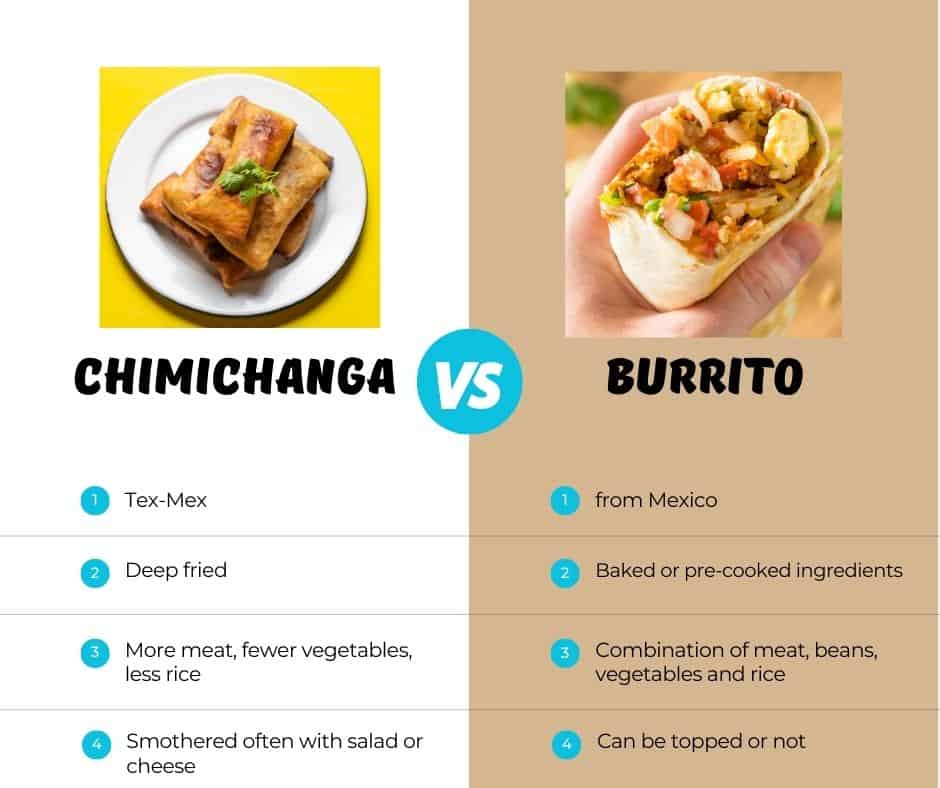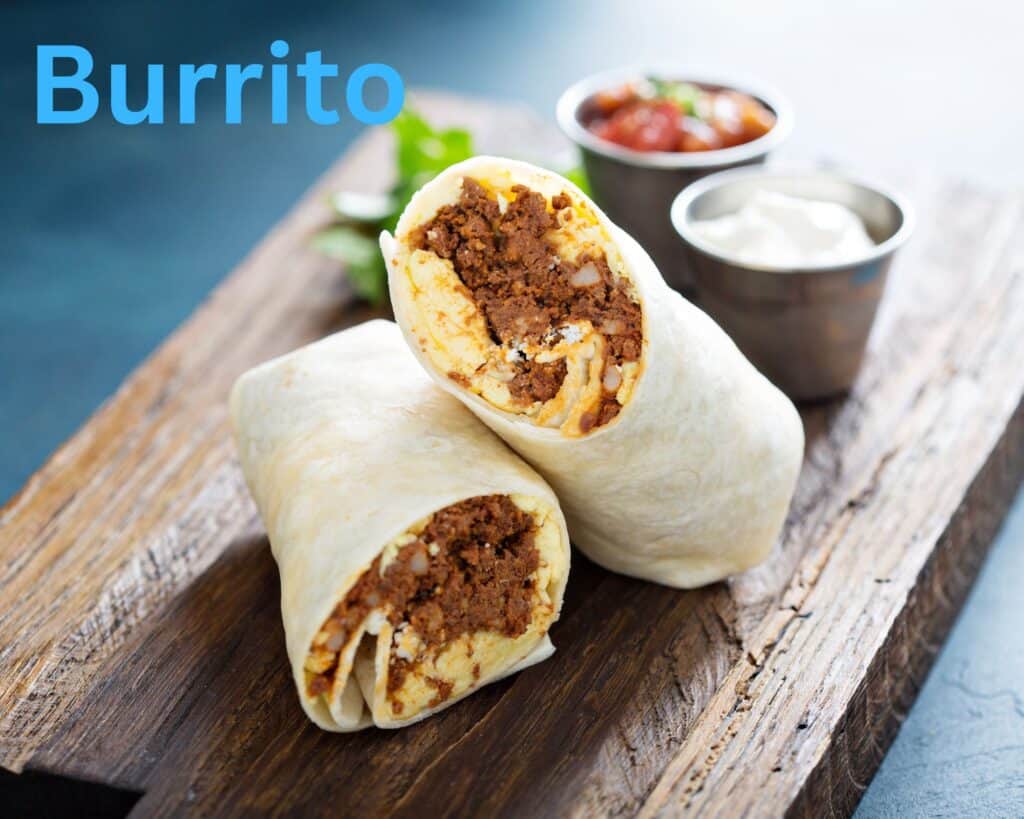If you’ve ever eagerly dug into a burrito or ordered a chimichanga from a food truck or other vendor, you know how delicious, comforting, and yes, even healthy both these dishes can be.
There’s just something about the combination of tortillas, cheese, protein, rice, and vegetables that’s a little bit magic, especially when put together well.
But, when it comes to these tortilla-wrapped bundles of joy, there is some confusion. After all, chimichangas and burritos are similar foods. So what is it that makes them different? Let’s dig in.

What Is Chimichanga?
The simplest answer is that chimichangas are deep-fried burritos, but there are some more differences than that.
For one thing, the ingredients and ratios of those ingredients are a bit different when it comes to chimichanga. Unlike a burrito, which may not need any additional cooking once it’s assembled, the ingredients in a chimichanga need to be able to handle deep frying.
The tortilla wrapper also needs to be able to stay closed during deep frying, which can put a limitation on how full it can be and may also force you to use more ingredients like cheese and meat that help glue everything together.
Chimichangas are also almost always served on a plate while serving a burrito can be a bit more versatile.

Different Types of Chimichanga
The main differences between chimichanga are in the fillings, which can range from classic Mexican combinations to modern fusion-style meals, or just whatever ingredients you happen to have on hand when you make one. Size can also be a difference, and the combination of both size and fillings can create hundreds of unique chimichanga.
- Mini-Chimi: mini-chimis are exactly what they sound like. Smaller in size, these chimichangas are perfect for a snack or a small meal, and you can eat several in one sitting. Sometimes, a mini-chimi might be a good option if you want to try several different fillings in one sitting.
- Smothered Chimichanga: Popular as a dish for both lunch and dinner, smothered chimichanga have a wide range of fillings + a hearty sauce or thick soup poured over the top. Both green chili and classic chili are popular options, or salsas, guacamole, and various cheese sauces.
- Chimi Colorado, Carne Asada Chimi, or Birria Chimichanga: All of these refer to specific seasonings, sauces, proteins, and veggie combinations that can easily go inside a chimichanga. These are just a few examples, there are a ton of different popular combinations, including many regional variations on each dish.
How Do You Make Chimichanga?
The first step to making a chimichanga is choosing the variety you want. Then, think about how the ingredients hold up during deep frying. If your recipe includes rice, remember that you want to keep a relatively small amount of rice in each chimi, or eliminate it entirely. Rice does not hold up well deep frying.
The same goes for some vegetables. Tomatoes are fine, as long as they’re relatively dry and contained. Peppers and onions are usually safe, but fresh herbs and other more delicate veggies should be excluded, or put on top of the finished chimi, not inside.
From there, wrap your ingredients in a tortilla, secure it, and deep fry until the tortilla is a rich golden color.
Delicious Chimichanga Ingredients
Chimichanga can have a ton of delicious ingredients from corn, refried beans, black beans, shredded chicken, carne asada, jalapenos and other hot peppers, onions, bell peppers, cheese, and seasonings.
Feeling a bit more adventurous? Try cooking your protein ahead in the carne asada, enchilada, or birria styles, and combine the resulting seasoned meat and sauce with your beans, cheese, and chosen vegetables for an incredibly flavorful meal!
Speaking of enchiladas, we’ve got a great weight-watchers-approved recipe for delicious chicken enchiladas.
Great Chimichanga Recipes You Should Try
Chimichangas can pack on calories sometimes, so we were delighted to find a delicious variation on the meal that uses moist chicken and an air fryer to capture the delicious taste of a great chimi without all the extra calories. Want to give it a try? This recipe from SkinnyTaste is a great way to go!
Want a more classic variant? This Food Network recipe for Carne Asada Chimichanga combines traditional and non-traditional ingredients for a recipe that’s all flavor and preserves the fresh light flavors that make Mexican food great.

What Is A Burrito?
Burritos are a bit more traditional than a chimichanga, though there is some debate whether the burrito belongs in traditional Mexican cuisine, or if it’s an early example of Tex-Mex foods pioneered by Northern Mexican Rancheros and Southern American Cowboys.
In its simplest form, a burrito is a combination of rice, beans, and other ingredients wrapped in a tortilla. The classic burrito was designed to be held in your hand and eaten on the go, but more modern versions include larger stuffed burritos, smothered burritos, and other variations that aren’t nearly as portable.
Different Styles Of Burrito
Like a chimichanga, there are as many different versions of burritos as there are ingredients to put in them. Modern burritos don’t even necessarily include rice, or beans, though most variations include at least one of those core ingredients.
- Guisado Burritos: these burritos are a combination of a thick Mexican stew, guisado, and a tortilla. Almost every guisado ever made has also been made into a burrito. The trick is getting the balance of flavors right, and using a high-quality fresh tortilla. The stew shouldn’t have too much broth, either, or it will just leak out of the tortilla.
- Bean and Cheese Burritos: A lot of people these days think of a bean and cheese burrito as a lunch item or a snack, but these are also traditional meals all on their own. The trick here is getting the seasoning and textures right. These should be flavorful and rich, not the one-note frozen burritos you get at the grocery store.
- Breakfast Burrito: Breakfast burritos come in many styles on their own, but the core of these burritos is almost always a combination of eggs, breakfast protein, and potatoes, with or without other vegetables. Salsas and cheese add some flavor and texture variety to these offerings.
- Mission Burritos: If you’re in the United States and you’ve ordered a burrito that didn’t have another style name attached, it was probably a Mission Burrito. These combinations of rice, fresh vegetables, seasoned protein, and optional additions of cheese, guacamole, and sour cream tend to be big, layered, and filling, if often less flavorful than guisado and other styles of burritos.
This is just a small sample, there are also San Francisco burritos with bigger chunks of meat and a pressed bake after assembly, California burritos, which add French fries, Burro Percheron, which combines carne asada and pepperoni, and many more!
How Do You Make a Burrito?
The trick of making a great burrito is in the balance of ingredients, and tightly wrapping the tortilla so the burrito is well-contained, but without making the tortilla split down the middle, or fall apart the moment you bite into it.
Aside from that, there are few consistent rules. Some people bake burritos after assembly, melting cheese on top, others use a burrito press or panini press to give the tortilla some color and crunch, without really baking the ingredients inside. Still, others use a combination of pre-cooked and raw ingredients, assemble them, and don’t worry about additional baking.
Burrito Ingredients and Toppings To Experiment With
There are too many burrito ingredients to list here, but we’ll provide a sample to help get you thinking: cheese, beans (refried, canned, or cooked), lime, chilies, rice, carne asada, shredded chicken, Fajita grilled meats, onions, sour cream, lettuce, tomatoes, avocado, eggs, chili, salsa, and much more!
Top Burrito Recipes You’re Sure To Love
Looking for a Mission-style burrito that feels fresh and familiar to most people in the United States? This recipe from Serious Eats has a great version of the burrito and adds flavor with some simple, but important, steps that can make any burrito better.
For a more authentically Mexican option, another Serious Eats Recipe for Machaca Guisada burritos uses simpler ingredients to create even more flavor.
Lastly, combine familiar Carne Asada flavors with more traditional guisado preparation for a Carne Guisada burrito that’s filling, flavorful, and great comfort food with this recipe from Kitchen Gidget!
Wrapping Up: What are the key differences between Chimichanga and Burrito?
The biggest difference between chimichangas and burritos is really just how the two meals are prepared, and how complex they can be. Chimichangas tend to have a slimmed-down list of ingredients and a drier, stickier filling to help them survive deep frying. Burritos have a lot more ingredient freedom, which almost makes them harder to define other than being wrapped in a tortilla.
Want the delicious flavors without the carbs of a tortilla? Our Taco Fiesta Bubble Up Casserole is a great alternative that gets some of the best Tex-Mex flavors in one easy-bake dish.
Both of these meals are delicious, come in fusion styles, and are great meals to get from restaurants and cook right in the comforts of your home. So, which one you prefer, is probably about the textures and flavors you love most, rather than the core differences between chimichanga and burrito.
Frequently Asked Questions (FAQs)
Q1: Are Chimichangas just a deep-fried Burrito?
Essentially, yeah. Some ingredient differences are common in chimichangas, like more meat, and less rice, but those are more norms than requirements. Deep frying is 100% what makes a burrito into a chimichanga.
Q2: Which is Healthier? Chimichangas vs. Burritos?
Burritos usually come out on top here. They aren’t fried, often have more vegetables, and the fattiest ingredients, like sour cream and cheese, are entirely optional in a burrito.
Q3: Why are there no Burritos in Mexico?
Burritos are really a combination of US and Mexican cuisine and are only considered part of Mexican cuisine in Northern Mexico. When you go further south, Mexican cuisine tends to focus more on older dishes that are more traditional for those regions, vs. the relatively new, American-influenced, burrito.
Q4: Why is Mexican Food so Unhealthy?
Mexican food isn’t actually necessarily unhealthy. When people ask this question they tend to be thinking more of Tex-Mex, which is a fusion cuisine that combines Mexican flavors with ingredients and combinations more common in the United States. More traditional Mexican cuisine has way more vegetables, slow-cooked meats, grains, and far less cheese and fats in general, and a lot more dishes without cheese at all.
Chimichanga vs Burrito

Ingredients
Instructions
- Choose your favorite recipe
- Click the link to view the instructions
- Follow the linked instructions
- Enjoy!

